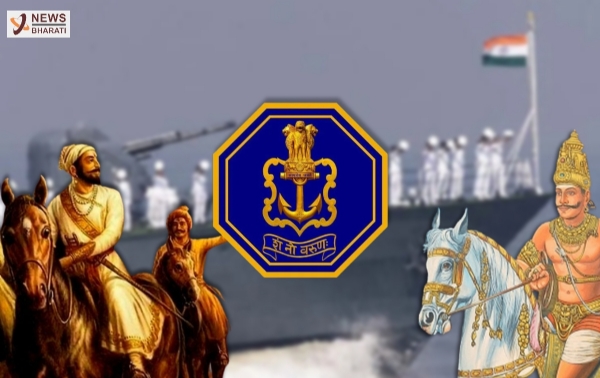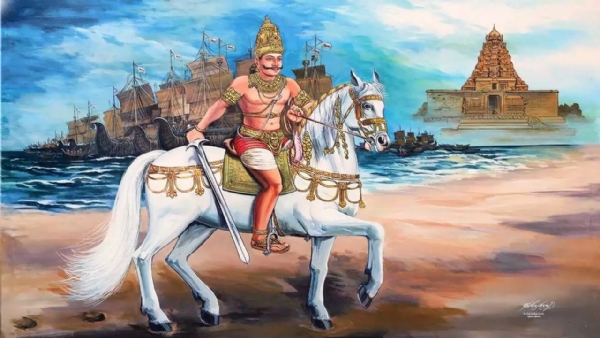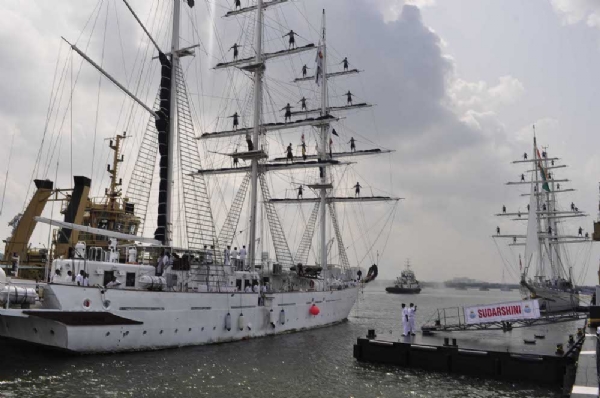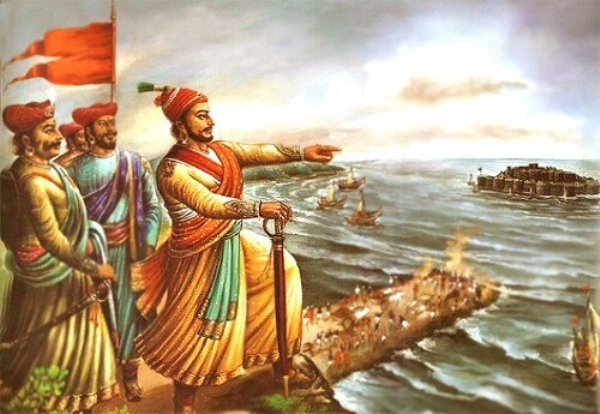New Naval Ensign Debate: Why Chh Shivaji Maharaj and why not Rajendra Chola?
The new naval ensign resembled the royal seal of the Marathas. It was a way to honor the Father of Indian Navy - Chhatrapati Shivaji Maharaj. However, soon after the unveiling ceremony a debate that had always been there came to the forefront.
Total Views |
The Indian Navy recently unveiled the new naval ensign of the national navy leaving behind the Victorian Cross that was on the initial flag. The new naval ensign resembled the royal seal of the Marathas. It was a way to honor the Father of Indian Navy - Chhatrapati Shivaji Maharaj. However, soon after the unveiling ceremony a debate that had always been there came to the forefront. Why Chhatrapati Shivaji Maharaj and why not Rajendra Chola? After breaking through the torturous rule of the British long back in 1947, witnessing such debate while celebrating the 75th year of independence, is nothing else but a thing of pity.

However, if we are raising questions then we should also try to find the answers of these questions. And more importantly let us ask the right questions? Who were Chhatrapati Shivaji Maharaj, Rajendra Chola? What are their contributions in the naval history of India? Why did the Indian Navy chose Chhatrapati Shivaji Maharaj over anybody else to be called the 'Father of Indian Navy'?
History of seafaring in India
The art of seafaring was not brought to India by European colonists. The earliest records of Indian seafaring are seen in the remains of the Harappan civilization, through ports like Lothal and seals with ships inscribed on them. Even when we travel around the Indian coasts we will find local deities that have links with those from Coastal Africa, as there has been cultural exchange between the two coasts since ancient times. There is enough evidence in Vedic literature as well to suggest the fact that Indians were aware of seafaring since ancient times.
However, moreover these chapters of India's naval history have been restricted to trade and commerce until the emergence of larger empires like that of the Mauryas, after the disintegration of the Mahajanapadas, when we actually get to see expansion of Indian powers based on their naval might. Kautilya's Arthashastra that is dated back to 2nd Century BC has been referred to establish an organized navy for centuries to come and is referred to even today.

There has always been observed that a discontinuity marks the study of dynasties in North and South. The most important reason here is the gradual change in terrain that also restricted several Northern rulers only until the Malwa region and hardly south of it. This phenomena has also led to two different stories of Indian History, where even at times there have been a deliberate effort to keep the History of Northern India and Southern India separate.
However, if we consider the period of ancient Indian History then the rulers of Southern India have aced their naval might and the Indian dynasties like the Cholas were able to expand their territories far away until where today's Vietnam is located. There are assumptions that the Cholas had went even farther than that in the East, however, studies are still ongoing.
Trisamudreshwar Rajendra Chola
The authors in the book 'Nagapattinam to Suvarnadwwipa' write, "In the civilizational history of India, the role of the Chola kings, particularly Rajaraja I and Rajendra Chola I in building a military maritime capability was unprecedented. The architecture of their pre-eminence was built through a series of expeditions in India — in the north, deep into the Indo-Gangetic plains through Odra-visaya (Orissa), Kosala, and Dandabhukti (Midnapur),in southern Radha near the mouth of Ganges; and from Venga (East Bengal),a westward expansion that saw the defeat of the Chera kingdoms on the Malabar coast; and well into the Deccan Plateau, with the defeat of the Chalukyas and the capture of their critical strongholds. In the west, the Cholas expanded towards the Arabian Sea, occupying the Lakshwadeep-Maldives archipelagos that sit astride the ancient Indian Ocean trade routes. They also made successive southward surges into Ceylon, attacking various Sinhala kingdoms"

Rajendra Chola is renowned for expanding his Kingdom that started in today's Tamil Nadu to South East Asian countries and winning the territories not by forceful invasions but by diplomacy and involving the region under the Chola sphere of influence. Therefore, I particularly skip mentioning war but refer to it as expansionism.
Here we need to understand that the primary motive behind Chola navy was exploration and expansion of territory and not defence and security. The Chola empire was already at its peak and had no threat of adversaries at the time.
When Indian Navy honored the Great Chola Naval Might
There is no way for anyone even remotely related to Indian navy to ignore the glory that is associated with the Chola navy, then how is it possible for the national navy to do so. In 2014, to commemorate 1000th anniversary of the coronation of ancient Tamil ruler Rajendra Chola, Indian Navy allied with the National Maritime Foundation and the Tamil Nadu state govt for celebrations.

In order for the same, INS Sudarshini, a circumnavigating ship was involved in the celebrations of a king, whose navy had gone beyond boundaries even in ancient times. The then Tamil Nadu Governor K Rosaiah flagged off INS Sudarshini from the Chennai Port to Nagapattinam, to symbolize achievements of the Chola Navy, whose ships have sailed and conquered lands in South-East Asia, which is present day Java, Sumatra and Malay Peninsula. So if anyone tells you that the Indian navy fails to honour Greatest navy of Indian history then at least know that you are being mislead.
Why Chhatrapati Shivaji Maharaj?
When we talk about the time of Chhatrapati Shivaji Maharaj we are talking about a completely phase of Indian history; when Indian land was accessible to invaders. Ever since the Portuguese sailor Vasco Da Gama discovered the sea route from Europe to India, another gate to conquer the ancient land was set open, making the western coast vulnerable to European naval invasions. European naval forces starting from the Portuguese were followed by the British, Dutch, Danish and lastly the French over the entire 17th century.
The foreign powers with strong navies had made it extremely clear that only the power with a strong navy will have control of the Indian land. The strong naval conflict between the European powers had no one to counter from the Indian land, because the knowledge of seafaring for the purpose of defence that was known to the dynasties of ancient India was not taken ahead with time.

Chhatrapati Shivaji Maharaj was the first Indian ruler of medieval India who realized the significance of dominating the sea, to counter the Europeans, which is when Kanhoji Angre became Maharaj's support. It is known that Kanhoji Angre, with the help of a Portuguese craftsman who built ships learned the technique of ship building and laid the foundation for the mightiest navy of medieval India.
The biggest difference between the Chola and Maratha navies is of the motive that led to their establishment. The Maratha navy was founded with the aim of defending Indian land from foreign invaders, to secure something that belongs to ourselves. The main intent of the present Indian navy is the same as that of Chhatrapati Shivaji Maharaj; to defend the Indian land, and differs from that of Rajendra Chola.
Today in the 21st century, India doesn't aim to be an expansionist power as India's freedom struggle has installed a different philosophy of foreign relations that India proudly stand by even today. That precisely might be the reason why the Indian navy calls Chhatrapati Shivaji Maharaj as the Father of Indian Navy; whereas nowhere does it emerge that the national navy abandons the belongingness to the legendary Cholas.


